Rhipicephalus spp.
Rhipicephalus (Boophilus) microplus | Rhipicephalus (Boophilus) decoloratus | Rhipicephalus appendiculatus | Rhipicephalus zambeziensis | Rhipicephalus evertsi evertsi
Rhipicephalus (Boophilus) microplus - Asian blue tick
The tick transmits bovine babesiosis (Babesia bovis and B. bigemina). Babesia bovis infection is acquired by the adults of one generation of ticks and transmitted transovarially by the larvae of the next generation. Because this tick transmits both B. bovis and B. bigemina it poses a greater potential threat to livestock production than R. (B.) decoloratus. Bovine anaplasmosis (Anaplasma marginale) and spirochaetosis (Borrelia theileri) are also transmitted by R. (B.) microplus.
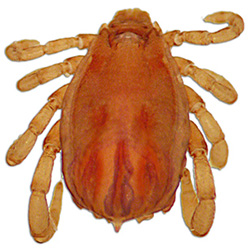
Rhipicephalus microplus |
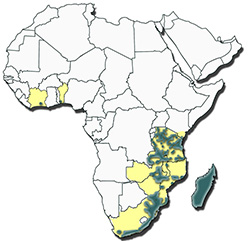
Distribution of Rhipicephalus microplus |
Domestic cattle are probably the only effective hosts of this tick, although several collections, including engorged females have been made from goats. There are very few records from wildlife and then only when domestic cattle were also present.
It has been postulated that R. (B.) microplus was introduced into East and South Africa from Madagascar, where it had originally arrived with cattle from southern Asia. In South Africa it is now established in scattered areas along the southern and eastern coasts of the Western and Eastern Cape Provinces and of KwaZulu-Natal. It is also present in the coastal regions of Mozambique, Tanzania and Kenya. In the interior it is found in scattered localities in Mpumalanga and Limpopo Provinces, South Africa, in parts of the eastern and central provinces of Zambia, throughout Malawi and to the east and north of Lake Malawi in Tanzania. There is evidence that where favourable moist and warm climatic conditions exist it competes with and is able to replace the indigenous R. (B.) decoloratus. R. (B.) microplus spread into Zimbabwe in the 1970s, when dipping was disrupted during the pre-independence war, and replaced R. (B.) decoloratus in several areas. By 1988 it had disappeared, possibly because of drought and the reintroduction of dipping. In Zambia, though, its westward spread appears to be continuing. In South Africa its distribution in the eastern regions of the Eastern Cape Province is expanding at the expense of that of R. (B.) decoloratus.
Recently, after 2000, R. (B.) microplus has also been found in West Africa, mainly in the Ivory Coast, Benin, Burkina Faso and Mali. The route of introduction is not known but is probably related to the importation of cattle, the principal host for this tick species from Brazil. Cattle have been imported into the Ivory Coast and Benin between 2000 and 2006 on several occasions and genetic analyses of R. (B.) microplus ticks collected in the Ivory Coast suggest a Latin American origin. There is a serious concern that this tick could spread to the entire West African region because of the favourable environment, high cattle densities, and cattle movements throughout the entire region.
Rhipicephalus (B.) microplus has a one-host life cycle, which in total takes about two months to complete. Several generations are possible, especially in those areas with a prolonged rainy season. Because of its one-host life cycle all stages of development occur on the host at the same time and the presence on a single host of approximately 70 engorged females can represent a total parasitic population exceeding 10 000 ticks.
Rhipicephalus (B.) microplus may be present in variable numbers throughout the year. Large numbers of larvae are usually present on pastures in late spring, and successive waves of larvae then occur through the summer and into the cooler autumn and early winter months.
Rhipicephalus (Boophilus) decoloratus – African blue tick
The common name of this tick is rather confusing as it is derived from the colour of the engorged female ticks, whereas the engorged females of several other tick species are also a blue colour.
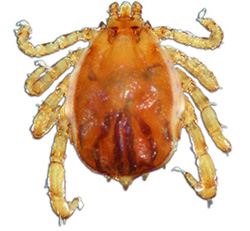 Rhipicephalus decoloratus male |
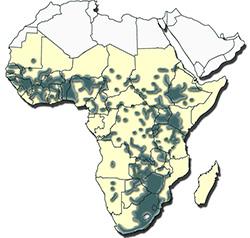
Distribution of Rhipicephalus decoloratus |
This tick transmits Babesia bigemina to cattle. The infection is transmitted only by the nymphal and adult stages after it has passed transovarially from one generation to the next. The incubation period in cattle is 12 to 14 days. Once established in the tick host B. bigemina can be transmitted by many successive generations without their acquiring new infection. Rhipicephalus (B.) decoloratus also transmits Anaplasma marginale to cattle, and Borrelia theileri, the cause of spirochaetosis, to cattle, sheep, goats and horses. Eland can be asymptomatic carriers of A. marginale and could thus serve as a reservoir of infection for domestic cattle. Rhipicephalus (B.) decoloratus is also suspected of being a vector of Babesia trautmanni, the cause of porcine babesiosis. However, the small numbers encountered on warthog, even in regions where large numbers of this tick are present, make this seem unlikely under field conditions.
Cattle, impalas (Aepyceros melampus), eland, bushbuck (Tragelaphus scriptus), greater kudu (Tragelaphus strepsiceros) and also horses and zebras are hosts of R. (B.) decoloratus.
The sides of the body, shoulders, neck and dewlap are preferred. The immature stages may be found on the tips and upper edges of the ears and on the legs.
This tick requires moisture and warmth. In South Africa it is found in the coastal regions of the Western and Eastern Cape Provinces, throughout KwaZulu-Natal, Mpumalanga, Gauteng, Limpopo and North West Provinces and the eastern half of the Free State. The species is distributed through most of the wetter regions of South Africa, except for those localities at which it has been replaced by R. (B.) microplus, and it also occurs in cold mountainous areas such as the Drakensberg range and parts of Lesotho. It is absent from the drier parts of South Africa which receive an average annual rainfall of less than 380 mm, including the western Free State, the central Karoo, Bushmanland and little Namaqualand. In the generally arid territory of Namibia it is present only in localized areas in the north, and in Botswana it is restricted to the higher rainfall eastern border areas and a few scattered localities in the north. It is also present in southern Mozambique, the eastern half of Zimbabwe, Angola, much of Zambia, Malawi, south-western and northern Tanzania, Burundi, Uganda, western Kenya and in the wetter highlands and sub-highlands of Ethiopia. It is also found in Mali and in Senegal.
There are several reasons for the displacement of R. (B.) decoloratus by R.(B.) microplus. The total length of the life cycle of R. (B.) decoloratus is longer than that of R. (B.) microplus and female R. (B.) decoloratus produce slightly less eggs than those of R.(B.) microplus. Part of the increase in distribution of R.(B.) microplus may thus be coupled to its shorter life cycle and higher egg production. Cross mating between the two species results in the production of sterile eggs, and although the male ticks prefer to mate with ticks of the same species, they will also mate with females of the other species. Males of R.(B.) microplus are sexually mature a few days sooner than those of R. (B.) decoloratus, and consequently in mixed infestations they stand a better chance of mating with R.(B.) microplus females. Should the sex ratio of male to female R.(B.) microplus be 2:1, as it is for R. (B.) decoloratus on field infested animals, the R.(B.) microplus males that do not find a R.(B.) microplus female could mate with R. (B.) decoloratus females, instead of the converse. If the females mate once only, the cross-mated females would produce sterile eggs and R. (B.) microplus would consequently comprise increasing proportions of future mixed populations of the two ticks.
Rhipicephalus (B.) decoloratus is a one-host tick. The ticks are active throughout the year where the climate is warm enough, with a peak in abundance during spring and another during late summer and autumn. Large numbers of synchronously hatching larvae are present on the vegetation and on hosts in spring. In cooler regions there may be little activity in the winter months.
Apart from the diseases they transmit, both R. (B.) decoloratus and R. (B.) microplus can have a significant impact on cattle production. On a mixed bushveld farm in Mpumalanga Province, South Africa, the weaning weights of calves of which the dams were predominantly infested with R (B). decoloratus, were reduced by approximately 8 g for each engorged female present on the cows. In Australia mid-lactation Holstein-Friesian cows were infested at weekly intervals with gradually increasing numbers of R (B.) microplus larvae for a period of 15 weeks. By week 15 uninfested control cows produced 2,86 l more milk and 0,14 kg more butterfat per day and had gained 10,6 kg more live-weight than the infested cows. It was estimated that each engorging female tick was responsible for a loss of 8,9 ml in daily milk production and 1,0g in body weight gain over the trial period.
Because much of the information on the effects of ticks on their cattle hosts has been obtained using experimental single species infestations, it is of limited value under field conditions in Africa since in most regions of the continent animals are infested with several species simultaneously. The effects of ticks are also often linked with those of tick-borne diseases and should be considered in conjunction with the latter. Furthermore cattle herds contain animals of different ages, sexes and types and experiments to determine the effects of ticks should be conducted on entire herds rather than on individual or selected age groups of animals.
Rhipicephalus appendiculatus - Brown ear tick
The name of this tick is derived from its brown colour and the fact that the adults attach to the ears of their hosts.

Rhipicephalus appendiculatus male |

Distribution of Rhipicephalus appendiculatus |
This tick is the main vector of Theileria parva, the causative organism of East Coast fever and Corridor disease in cattle. Transmission takes place from stage to stage. Buffalo are the source of the T. parva strain causing Corridor disease in cattle. No clinical signs are seen in the buffaloes and the larvae or nymphs or R. appendiculatus acquire infestation when they feed on infected buffaloes. Should the ensuing nymph or adult ticks feed on cattle transmission of the organism occurs and the cattle will develop Corridor disease. Transmission from buffaloes to cattle usually takes place when buffaloes break out of reserves onto surrounding cattle farms and engorged infected R. appendiculatus nymphs then detach from them. These nymphs will moult to adults which will then feed on cattle on the farm and transmit the disease. R. appendiculatus also transmits benign bovine theileriosis caused by Theileria taurotragi, bovine anaplasmosis (A. marginale) and the virus of Nairobi sheep disease. Infection with T. taurotragi may cause severe or even fatal disease in eland. In small wildlife parks situated in high rainfall regions large infestations with R. appendiculatus can constitute a serious problem in several antelope species.It is also responsible for the transmission of Rickettsia conorii to humans. It is hypothesized that the saliva of R. appendiculatus contains a toxin and if large numbers of ticks infest an animal this toxin can interfere with the immune processes of the host, resulting in a loss of condition and outbreaks of babesiosis, anaplasmosis and heartwater in animals that were previously immune to these diseases. Severe infestations can lead to crumpling of the ear and infestations of the ear with the larvae of Chrysomya bezziana may occur.
Large numbers of both adult and immature ticks can be found on cattle, goats, African buffalo, eland, male nyala (Tragelaphus angasii), greater kudu and sable antelope (Hippotragus niger). Some adults and large numbers of immatures can occur on smaller antelopes and only immatures on scrub hares.
This tick is an eastern, central and southern African species. Its distribution extends from southern Sudan, Uganda, south-western Kenya, eastern Democratic Republic of the Congo, Rwanda and Burundi, to northern, north-eastern, central and south-western Tanzania. In southern Africa it is confined to the moister regions, which include the highlands of Malawi, Zambia, Mozambique (Angonia and Chimoio Districts), and Zimbabwe. It is also present in eastern Botswana and in Swaziland. The extent of its distribution in the coastal regions of Mozambique is unknown. In South Africa it is present in the Limpopo, North-West, Gauteng and Mpumalanga Provinces, along the east coast of KwaZulu-Natal and the coastal regions of the Eastern Cape Province to Grahamstown in the west of the latter province. There are also foci in the Ermelo and Carolina districts in Mpumalanga and Vredefort in the Free State.
This is a three-host tick. The entire life cycle can be completed in 3 months but in the southern regions of the tick's distribution it probably takes a year to complete.
Rhipicephalus appendiculatus has a strictly seasonal, single annual life cycle in southern Africa. Adults occur during the rainy period (December to March), larvae in the cooler late summer to winter period after the rains (March to July) and nymphs in the winter and early spring (July to October). The pattern of seasonal occurrence is regulated by the unfed adults, which enter diapause and do not engage in host seeking until the rains start. In regions close to the equator more than one life cycle can be completed annually and no clear pattern of seasonal abundance may be evident.
Rhipicephalus zambeziensis
Rhipicephalus zambeziensis is the vector of Corridor disease (Theileria parva), benign bovine theileriosis (Theileria taurotragi) and ehrlichiosis (Erhlichia bovis).

Rhipicephalus zambeziensis male |
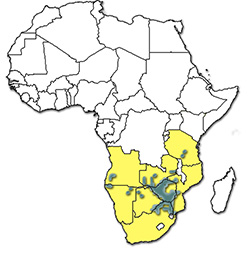
Distribution of Rhipicephalus zambeziensis |
Rhipicephalus zambeziensis is closely related to R. appendiculatus, and the two are morphologically very similar. The major difference between the adults of the two species is that R. zambeziensis has more conspicuous punctations on the scutum. The immature stages are more easily differentiated than the adults.
The tick has the same hosts as those used by R. appendiculatus during its adult and immature stages. Adults are found on the head and ears and on the muzzles, and immatures on the feet and legs.
Rhipicephalus zambeziensis replaces R. appendiculatus in the hot, dry river valley systems of south-eastern Africa (Luangwa, Kafue, Zambezi, Sabi and Limpopo Valleys) that separate the major highland areas. It is present in the dry environments of northern Namibia and in the lowland areas of the Mozambique interior. The distributions of R. zambeziensis and R. appendiculatus overlap where there are gradual transitions between wet and dry areas. This occurs in parts of the eastern and southern provinces of Zambia bordering the Zambezi Valley, eastern Botswana and in North-West, Limpopo and Mpumalanga Provinces, South Africa. Some interspecific hybridization may occur. R. zambeziensis is absent from semi-desert and desert areas.
This is a three-host tick. Adults are most numerous in the late summer, larvae during autumn and winter and nymphs during winter and spring.
Rhipicephalus evertsi evertsi - the red-legged tick
This tick’s common name is derived from the light to dark orange colours of its legs.

Rhipicephalus evertsi evertsi male |

Distribution of Rhipicephalus evertsi evertsi |
Rhipicephalus evertsi evertsi may play a role in the transmission of Theileria parva to cattle, but if it does it is not an important vector. It transmits Babesia equi and Babesia caballi to horses stage to stage only. B. equi and B. caballi are also transmitted intra-uterinely in horses. It has been demonstrated experimentally that it can transovarially transmit B. bigemina to cattle. Stage to stage transmission of Theileria separata to sheep also occurs. Transmission of B. theileri, the cause of spirochaetosis in cattle, horses, sheep and goats has also been reported. The saliva of engorging female ticks contains a toxin that causes paralysis, particularly in lambs, but it may also affect calves and adult sheep. This toxicosis is known as spring lamb paralysis because of its seasonal occurrence. In the eastern highveld regions of the Mpumalanga and Free State Provinces, South Africa the synchronous moulting of free-living over-wintered nymphs gives rise to large numbers of adults on spring-born lambs. The engorging females secrete a toxin resulting in paralysis. Several females are necessary to produce this effect and they must have fed for about 5 days and weigh between 15 and 21 mg each. The clinical signs can be reversed by removal of the ticks. Large infestations of immature ticks may damage the ear canal of its host.
Adults prefer horses, zebras, elands, cattle and sheep. Larvae and nymphs utilise the same hosts as the adults and also scrub hares and various antelopes. The adults are found on the hairless area around the anus as well as the inguinal region of equids and sheep. The immature stages attach deep in the ear canals.
This is a two-host tick. These ticks are active mainly during the summer but are present throughout the year in warm regions.
A very similar tick Rhipicephalus evertsi mimeticus, known as theNamibian red-legged tick,looks like R. evertsi evertsi, but has red and ivory-coloured banded legs similar to those of certain Hyalomma spp. This tick occurs in western Botswana, central and northern Namibia and southern and western Angola and transmits Theileria equi the cause of equine piroplasmosis and Theileria separata, the cause of ovine theileriosis.
